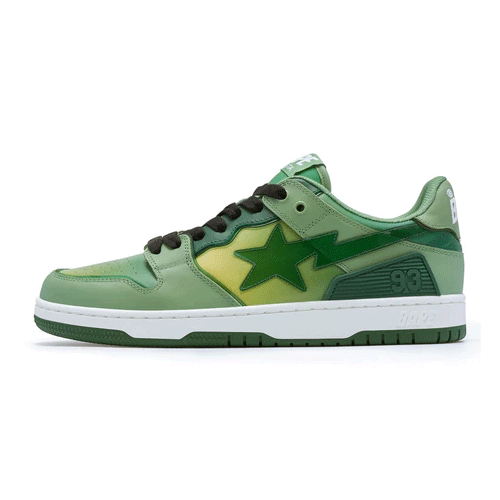In the ever-evolving world of streetwear, few sneakers hold the kind of cultural weight that the Bapesta does. Loved by collectors, worn by celebrities, and embedded deeply into hip-hop fashion, the Bapesta isn’t just a shoe — it’s a statement. Known for its bold design, striking colorways, and deep roots in street culture, the Bapesta has transcended trends to become a mainstay in global fashion.
Whether you’re new to the streetwear scene or a long-time sneaker enthusiast, understanding the journey of the Bapesta offers valuable insight into how fashion and culture collide to create timeless icons.
The Origins of Bapesta: From Tokyo to the World
The Bapesta was first released by A Bathing Ape (BAPE), a Japanese streetwear brand founded by Nigo in 1993. But it wasn’t until 2002 that the world saw the first Bapesta sneaker — a silhouette that instantly raised eyebrows.
Drawing inspiration from the classic Nike Air Force 1, the Bapesta featured a similar low-top profile and paneling. However, what set it apart was the distinctive star logo (replacing the Nike swoosh), often flashy patent leather materials, and an explosion of vibrant, mismatched colorways that made each pair feel like wearable pop art.
The early 2000s streetwear scene was a melting pot of hip-hop, skate culture, and Japanese fashion. The Bapesta sat perfectly at the intersection of these worlds, offering something rebellious, premium, and visually unforgettable. This wasn’t a quiet sneaker — it demanded attention.
Bapesta and Hip-Hop: A Cultural Fusion
Much of Bapesta’s meteoric rise in the early 2000s can be attributed to its embrace by hip-hop culture. Influential artists like Pharrell Williams, Kanye West, and Lil Wayne were often seen rocking the colorful sneakers, helping Bapesta reach an international audience.
Pharrell and Nigo collaborated extensively during the early years, with Pharrell becoming something of a Western ambassador for BAPE. The sneakers appeared in music videos, album covers, and street style shoots, helping cement their status as must-haves in the wardrobes of artists and fans alike.
By aligning itself with music and street fashion, Bapesta created a brand narrative that was far more than just sneakers. It stood for individuality, expression, and the rebellious confidence of youth culture.
The Design Language: Why Bapestas Stand Out
At first glance, the Bapesta may seem like just another colorful sneaker. But a closer look reveals the meticulous design ethos behind each release.
The patent leather uppers, which are often the first thing that catches the eye, were ahead of their time. While many sneakers today embrace shiny, high-gloss finishes, Bapesta was doing it more than two decades ago. The STA logo — a stylized star shooting across the mid-panel — is instantly recognizable and speaks to the brand’s roots in cartoon and anime culture.
Limited edition drops, artist collaborations, and unpredictable color blocking have become trademarks of the line. No two Bapesta collections look the same, and this sense of scarcity and creativity keeps collectors coming back year after year.
Modern Bapesta: Reinvention and Relevance
While the early 2000s were the golden age of Bapesta, the brand never disappeared. In fact, in recent years, BAPE has doubled down on its commitment to the sneaker line, introducing new Bapesta silhouettes like the Bapesta Mid and bringing back OG colorways in refreshed formats.
In 2023 and 2024, collaborations with contemporary artists and designers, including Kid Cudi, ASAP Rocky, and Skepta, gave the line renewed visibility. Social media platforms like TikTok and Instagram helped showcase Bapesta’s aesthetic appeal to a new generation of fashion-savvy youth who value uniqueness and cultural heritage in their clothing choices.
The Bapesta also fits neatly into the ongoing Y2K revival in fashion, with many fans of early 2000s style embracing the sneaker for its nostalgia and graphic-heavy design.
How to Style Bapestas in 2025
Bapestas are statement pieces, so it’s important to style them with intention. Whether you’re going for a retro vibe or a modern twist, these sneakers can elevate almost any outfit.
Oversized cargo pants, graphic tees, varsity jackets, and accessories like bucket hats and chains work seamlessly with Bapestas. For a more elevated look, some fashion influencers pair them with structured streetwear — think tailored joggers, layered hoodies, and muted palettes that let the sneakers pop.
What makes the Bape versatile is that while the shoe itself is loud, it pairs equally well with both minimalist and maximalist outfits. This adaptability has helped it remain relevant in a fast-moving fashion landscape.
Bapesta in the Resale Market
The resale market has played a significant role in keeping the Bapesta’s legacy alive. While not as widely available as some mainstream sneakers, limited drops and collabs make certain Bapesta colorways highly coveted.
Collectors often seek out rare editions — such as the Kanye West Bapesta “Dropout Bear”, or Pharrell’s custom pairs — that fetch high prices in the resale market. Platforms like StockX, GOAT, and Grailed frequently list vintage and new Bapestas, showcasing how the sneaker continues to hold value both financially and culturally.
The Future of Bapesta: More Than a Trend
As we move deeper into 2025, it’s clear that the Bapesta isn’t going anywhere. Its combination of bold design, deep cultural roots, and cross-generational appeal makes it more than just a passing trend. The brand’s ability to evolve — without losing its identity — ensures that it continues to resonate with both longtime fans and new enthusiasts.
From Tokyo streets to global fashion capitals, Bapesta has carved out a space that’s entirely its own. And while fashion will always chase the next big thing, some icons, like the Bapesta, remain timeless because they never tried to fit in — they stood out.
Final Thoughts: Why Bapesta Still Matters
The Bapesta isn’t just a sneaker. It’s a cultural artifact, a fashion rebellion, and a symbol of streetwear’s global rise. It embodies the perfect blend of style, influence, and individuality. Whether you wear it for the aesthetic or collect it for its legacy, one thing is certain: owning a pair of Bape is like owning a piece of fashion history.
Related Reads
- Custom Fitness App Development: Build the Fitness App Your Users Actually Want
- Discovering the Best Cafes in Utah with Salt & Seek
- Fast Estate Cleanouts in Palm Beach Gardens, FL Experts
- Trapstar Tracksuit – The Streetwear Icon Redefined
- Suv Car Rental Bangalore – Comfort, Space, and Convenience with Savari Holidays
- Interior Design Services in Kochi: Transform Your Space with Luxhouse Interiors



